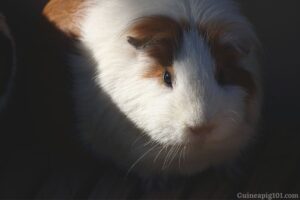Do guinea pigs change colors?
Color changes in the fur of guinea pigs are common, occurring once or twice a year on average. In addition to this, baby guinea pigs change their color on a regular basis until they reach adulthood. As a result of the regular shedding of fur and the rapid rate of growth, this occurs.
Guinea pigs, in contrast to other animals, are born with fur. When they are 3-4 months old, they shed their first fur coat, which is quickly replaced with a new fur coat of the same color and pattern, but the color and pattern do not appear to match.
A significant difference in color and pattern will be observed in the majority of cases as the guinea pigs progress through their childhood to adulthood.
Additionally, every six months, when they shed and prepare their coat for the climate in which they are living, there will be a slight variation in the color of their fur.
Guinea pigs shed their coats in response to the change in seasons, as they require a thinner fur coat in the summer than they do in the winter, and vice versa.
The change in color of the guinea pigs occurs for a variety of reasons, including their protection. It is more common in wild guinea pigs than in pet guinea pigs, but it can occur in any guinea pig, with the exception of skinny pigs.
The amount of melanin in their skin also has a small effect on the color of their skin. Unless you keep your guinea pigs outside or in close proximity to a window where they receive plenty of light, a little variation is to be expected.
Guinea pigs’ fur will become darker in color during the summer months, as the amount of melanin produced by the animals increases significantly. During the winter, however, the days become shorter and the production of melanin decreases, resulting in a lighter shade of coat color.
Guinea pig shedding fur
As previously stated, guinea pigs shed their fur every six months, in conjunction with the changing of the seasons. It could take anywhere between 2 and 6 weeks to completely shed your fur.
Moulting usually begins with the head and progresses to the lower body over a period of several weeks or months.
Every pair of guinea pigs, on the other hand, is distinct from the other. A significant portion of the fur of some guinea pigs is shed in a short period of time, whereas other guinea pigs shed in small, uneven amounts over time.
When guinea pigs shed their hair, they develop bald spots on their bodies. There is no reason to be concerned if the patch disappears as their fur regrows on its own accord.
If, on the other hand, you notice bald hair spots on your guinea pigs that persist for several days, this indicates that your guinea pigs are pulling out their fur, possibly as a result of stressful circumstances.
Guinea pigs can be stressed for a variety of reasons, and you can help them by brushing them on a regular basis.
Make use of a comb with broad teeth and unsharpened ends to comb your hair. Guinea pigs have delicate skin, and using sharp pointed brushes or combs can be painful for them to bear.
The majority of the time, guinea pigs brush themselves on their own, especially during periods of shedding. Hairballs can develop in your guinea pigs as a result of this.
Summer is the most common time for this to occur because they shed a lot during this time. Make sure that your guinea pigs have plenty of hay to eat so that their digestion will be as easy as possible.
If you want your guinea pigs to get over this shedding as quickly as possible, increase the amount of protein in their diet. Your guinea pigs will shed more quickly if you feed them the right amount of protein.
However, an excessive amount of protein causes the digestive system to work slowly, which can be extremely harmful because guinea pigs are unable to vomit, which is especially dangerous during the time of shedding.
If guinea pigs are experiencing digestive difficulties, it is likely that the fur they swallowed has become lodged in their digestive tract. It is possible that this will result in gastrointestinal stasis.
Guinea pig fur getting darker
Guinea pigs’ fur becomes lighter in color in the winter and darker in the summer, depending on the season. The presence of melanin in their bodies, which is produced as a result of exposure to sunlight, causes their fur to darken (direct or indirect).
Guinea pigs are more active during the early morning and late evening hours because they are crepuscular creatures. The majority of pet guinea pigs attempt to become more active during the daytime, which occurs because they are born and raised in a confined space from birth.
It has been observed by many guinea pig owners that their babies’ fur will darken when they are exposed to the elements or in bright light for extended periods of time.
Top-Rated Guinea Pig Supplies: Our Top Picks! Recommended Guinea Pig Supplies: Our Top Picks!
Before you read on, here are some supplies for your guinea pigs that have been hand-picked by our experts and that you should add to your wishlist right away:
Guinea pig fur getting lighter
Because the daylight hours are limited during the winter, guinea pigs are outfitted in light-colored fur coats. Because the type of fur coat guinea pigs get in the winter is typically thicker, you will be able to notice it right away.
If your guinea pig lives in a bright environment, its fur will be a darker shade, whereas if your guinea pig lives in a dark environment, its fur will be a lighter shade of brown.
Guinea pig fur turning yellow
Changing the color of guinea pigs’ fur from brown to yellow is caused by two different factors. One possibility is direct sunlight exposure, which results in fur staining.
Urine scald
The yellow color of guinea pigs’ fur is caused by stains left on their fur by their urine.
Gourmand guinea pigs spend their time amusing themselves while they eliminate their waste.
The consumption of dry grass by guinea pigs at the same time that they eliminate is not uncommon.
In the minds of your guinea pigs, this action creates the impression that there is a connection between eating and eliminating at the same time.
Several guinea pigs enjoy playing in their litter box, and some of them even sleep in it at night. If your guinea pigs are doing this, they are, unfortunately, coming into contact with their urine.
Bathing is not recommended because guinea pigs are susceptible to electric shocks, which can result in heart attacks in some cases. Alternatively, you could try cleaning them slowly with a wet cloth, or mixing vinegar with water and dabbing it on their fur to remove stains from their fur.
It is possible that urine stains will remain on the soft skin of guinea pigs for an extended period of time, causing urine burnings on the skin. This results in bald spots on the guinea pig’s coat, which is painful for the animal.
As an example, longer urine stains can attract flies and other insects, and if these insects lay eggs on the skin, it results in a condition known as flystrike (see below). Flystrike can be extremely dangerous to your guinea pigs’ lives.
Do guinea pigs get gray hair?
Some guinea pigs have a fur coat that is naturally grey in color. However, the fur of guinea pigs does not become grey as a result of their increasing age.
Guinea pigs are considered to be adults when they reach the age of 5 years. Guinea pigs have a natural life expectancy of approximately 5-8 years, according to current research. The following are signs that your guinea pigs are getting older:
Having fewer movements and sleeping for shorter periods of time.
Variations in weight have been observed; several guinea pigs have become overweight as a result of overeating, whereas the majority of older guinea pigs refuse to eat.
Grooming is not a priority, and failure to groom is unacceptable.
Removing waste from outside the waste box is necessary because guinea pigs suffering from arthritis may have difficulty climbing on top of the waste box.
Spots or pimples on the skin that are swollen.
When they are unable to see or respond appropriately, they respond less aggressively.
Guinea pigs changing fur color is natural and common. If you find that your guinea pigs are not changing color at all, then it could be because of their genetics.
Also, the yellowing of fur in your guinea pigs is not dangerous, and they are not suffering from any health problems unless and until it is caused by urine stain. Urine stain is something you need to pay immediate attention to.
When your guinea pigs begin to change their fur color, you should help them by providing grooming.
It may appear that your guinea pigs are shedding all the time, but it is essential for their care, particularly for those breeds with long hair like Peruvian guinea pigs.
Your guinea pig’s fur color changes are due to natural factors. Do not worry about your guinea pigs if they have darker fur shade in summers and a lighter shade in winters.




